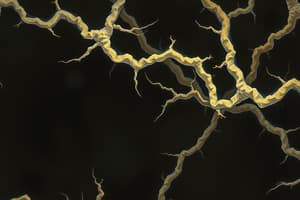Podcast
Questions and Answers
Which of the following is a characteristic of hyaluronan?
Which of the following is a characteristic of hyaluronan?
- Composed of D-glucuronate + GlcNAc
- Composed of 25,000 subunits (correct)
- Made directly inside the cell
- Has a high sulfate content
GAGs are exclusively found within cells.
GAGs are exclusively found within cells.
False (B)
What is the primary role of proteoglycans in the extracellular matrix?
What is the primary role of proteoglycans in the extracellular matrix?
They provide structural support and facilitate cell signaling.
Heparin is composed of D-glucuronate-2-sulfate + N-sulfo-D-______.
Heparin is composed of D-glucuronate-2-sulfate + N-sulfo-D-______.
Match the following GAGs with their composition:
Match the following GAGs with their composition:
What is the primary function of endostatin?
What is the primary function of endostatin?
Elastic fibers are primarily composed of collagen.
Elastic fibers are primarily composed of collagen.
What enzyme is responsible for the deamination of collagen fibrils?
What enzyme is responsible for the deamination of collagen fibrils?
The major component of elastic fibers is __________.
The major component of elastic fibers is __________.
Match the following components with their functions:
Match the following components with their functions:
What happens to elastin as a person ages?
What happens to elastin as a person ages?
The cross-links formed by desmosine and isodesmosine are vital for the elasticity of connective tissues.
The cross-links formed by desmosine and isodesmosine are vital for the elasticity of connective tissues.
What is the elastic modulus of elastic fibers approximately?
What is the elastic modulus of elastic fibers approximately?
Which of the following is NOT a component of the extracellular matrix (ECM)?
Which of the following is NOT a component of the extracellular matrix (ECM)?
The extracellular matrix provides structural support and regulates cell differentiation.
The extracellular matrix provides structural support and regulates cell differentiation.
What type of structure characterizes collagen molecules?
What type of structure characterizes collagen molecules?
Which of the following is an example of an adhesive glycoprotein?
Which of the following is an example of an adhesive glycoprotein?
Elastin is known for its ________ and is often compared to a rubber band.
Elastin is known for its ________ and is often compared to a rubber band.
Proteoglycans are considered to primarily provide structural support in the ECM.
Proteoglycans are considered to primarily provide structural support in the ECM.
Match the following components of the extracellular matrix with their respective functions:
Match the following components of the extracellular matrix with their respective functions:
Which amino acids are abundant in collagen molecules?
Which amino acids are abundant in collagen molecules?
What is the primary role of adhesive glycoproteins in the extracellular matrix?
What is the primary role of adhesive glycoproteins in the extracellular matrix?
Proteoglycans consist of protein-carbohydrate complexes that contribute to the volume within the ECM.
Proteoglycans consist of protein-carbohydrate complexes that contribute to the volume within the ECM.
Laminin is a large multiadhesive matrix protein found in all __________.
Laminin is a large multiadhesive matrix protein found in all __________.
Match the following components with their roles in the extracellular matrix:
Match the following components with their roles in the extracellular matrix:
Define adhesive glycoproteins and provide two examples.
Define adhesive glycoproteins and provide two examples.
Which statement is true regarding the extracellular matrix (ECM)?
Which statement is true regarding the extracellular matrix (ECM)?
Type IV collagen is an important component of the basal lamina.
Type IV collagen is an important component of the basal lamina.
Name a key characteristic of fibrous proteins.
Name a key characteristic of fibrous proteins.
Study Notes
Extracellular Matrix (ECM) Composition
- ECM is the milieu outside the cell.
- Major ECM components include fibrous proteins, proteoglycans, and adhesive glycoproteins.
- Fibrous proteins provide tensile strength and elasticity (e.g., collagen, elastin).
- Proteoglycans are protein-carbohydrate complexes that give volume, support cell adhesion, and bind growth factors.
- Adhesive glycoproteins mediate cell adhesion (e.g., fibronectin, laminin).
Collagen
- Abundant amino acids in collagen include glycine, proline, and hydroxyproline.
- Collagen features a triple helix structure (three fibers intertwined).
- Synthesized as procollagen, which is processed into tropocollagen.
- Fibril-forming or fibril-associated collagens are insoluble.
Elastin
- Provides elasticity to tissue.
- Rich in hydrophobic amino acids.
- Insoluble and synthesized as proelastin, which is processed into tropoelastin.
- Cross-linked outside the cell to form insoluble elastin.
Collagen vs. Elastin
- Collagen provides tensile strength and resistance to stretching.
- Elastin allows tissues to deform and recoil.
Proteoglycans
- Proteoglycans are proteins attached to glycosaminoglycans (GAGs).
- GAGs are highly diverse with varying core proteins, GAG compositions, lengths, and sulfation patterns.
- Examples of GAGs include hyaluronic acid, chondroitin sulfates, dermatan sulfate, keratan sulfates, heparin, and heparan sulfates.
Adhesive Glycoproteins
- Long flexible molecules with binding domains.
- Bind ECM to cells.
- Examples include:
- Fibronectin
- Laminin
Basal Lamina
- A specialized ECM layer that underlies epithelial tissues.
- Composed of type IV collagen, laminin, nidogen, and perlecan.
- Provides structural support and serves as a barrier between tissues.
Key takeaways
- ECM is vital and dynamic, playing a crucial role in tissue structure and function.
- Collagen and elastin contribute to tissue strength and elasticity.
- Proteoglycans are important for tissue volume, cell adhesion, and growth factor binding.
- Adhesive glycoproteins mediate cell interactions with the ECM.
- The basal lamina is a specialized ECM layer with crucial functions in tissue integrity and cell signaling.
Studying That Suits You
Use AI to generate personalized quizzes and flashcards to suit your learning preferences.
Related Documents
Description
Explore the intricate details of the extracellular matrix (ECM) and its key components, including collagen and elastin. This quiz covers the structure, synthesis, and roles of fibrous proteins, proteoglycans, and glycoproteins in providing tissue support and elasticity. Test your understanding of these essential biological materials.




